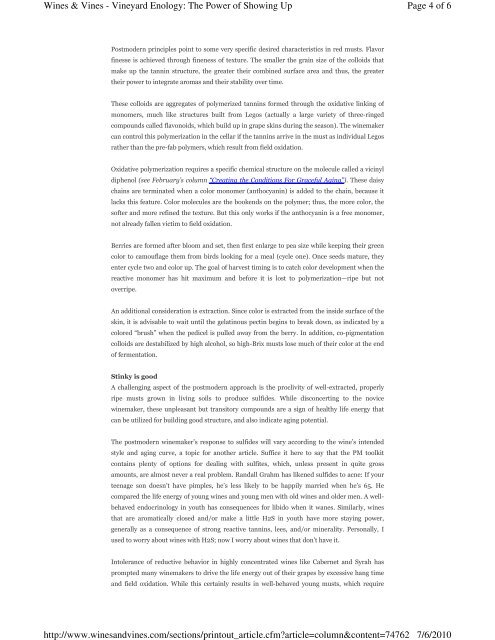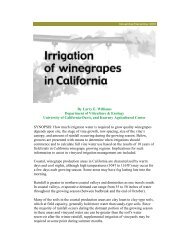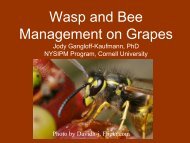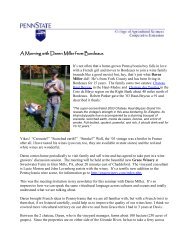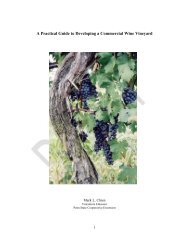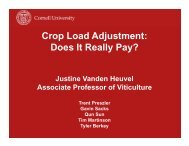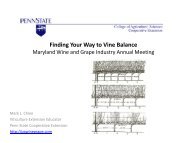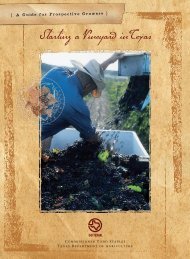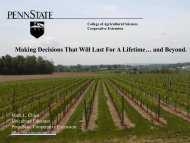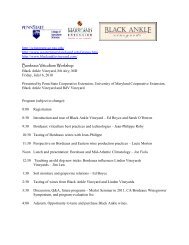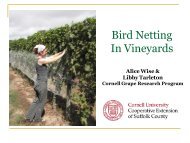Post Modern Winemaking_Clark Smith.pdf - PA Wine Grape ...
Post Modern Winemaking_Clark Smith.pdf - PA Wine Grape ...
Post Modern Winemaking_Clark Smith.pdf - PA Wine Grape ...
Create successful ePaper yourself
Turn your PDF publications into a flip-book with our unique Google optimized e-Paper software.
<strong>Wine</strong>s & Vines - Vineyard Enology: The Power of Showing Up<br />
http://www.winesandvines.com/sections/printout_article.cfm?article=column&content=74762<br />
Page 4 of 6<br />
7/6/2010<br />
<strong>Post</strong>modern principles point to some very specific desired characteristics in red musts. Flavor<br />
finesse is achieved through fineness of texture. The smaller the grain size of the colloids that<br />
make up the tannin structure, the greater their combined surface area and thus, the greater<br />
their power to integrate aromas and their stability over time.<br />
These colloids are aggregates of polymerized tannins formed through the oxidative linking of<br />
monomers, much like structures built from Legos (actually a large variety of three-ringed<br />
compounds called flavonoids, which build up in grape skins during the season). The winemaker<br />
can control this polymerization in the cellar if the tannins arrive in the must as individual Legos<br />
rather than the pre-fab polymers, which result from field oxidation.<br />
Oxidative polymerization requires a specific chemical structure on the molecule called a vicinyl<br />
diphenol (see February’s column “Creating the Conditions For Graceful Aging”). These daisy<br />
chains are terminated when a color monomer (anthocyanin) is added to the chain, because it<br />
lacks this feature. Color molecules are the bookends on the polymer; thus, the more color, the<br />
softer and more refined the texture. But this only works if the anthocyanin is a free monomer,<br />
not already fallen victim to field oxidation.<br />
Berries are formed after bloom and set, then first enlarge to pea size while keeping their green<br />
color to camouflage them from birds looking for a meal (cycle one). Once seeds mature, they<br />
enter cycle two and color up. The goal of harvest timing is to catch color development when the<br />
reactive monomer has hit maximum and before it is lost to polymerization—ripe but not<br />
overripe.<br />
An additional consideration is extraction. Since color is extracted from the inside surface of the<br />
skin, it is advisable to wait until the gelatinous pectin begins to break down, as indicated by a<br />
colored “brush” when the pedicel is pulled away from the berry. In addition, co-pigmentation<br />
colloids are destabilized by high alcohol, so high-Brix musts lose much of their color at the end<br />
of fermentation.<br />
Stinky is good<br />
A challenging aspect of the postmodern approach is the proclivity of well-extracted, properly<br />
ripe musts grown in living soils to produce sulfides. While disconcerting to the novice<br />
winemaker, these unpleasant but transitory compounds are a sign of healthy life energy that<br />
can be utilized for building good structure, and also indicate aging potential.<br />
The postmodern winemaker’s response to sulfides will vary according to the wine’s intended<br />
style and aging curve, a topic for another article. Suffice it here to say that the PM toolkit<br />
contains plenty of options for dealing with sulfites, which, unless present in quite gross<br />
amounts, are almost never a real problem. Randall Grahm has likened sulfides to acne: If your<br />
teenage son doesn’t have pimples, he’s less likely to be happily married when he’s 65. He<br />
compared the life energy of young wines and young men with old wines and older men. A wellbehaved<br />
endocrinology in youth has consequences for libido when it wanes. Similarly, wines<br />
that are aromatically closed and/or make a little H2S in youth have more staying power,<br />
generally as a consequence of strong reactive tannins, lees, and/or minerality. Personally, I<br />
used to worry about wines with H2S; now I worry about wines that don’t have it.<br />
Intolerance of reductive behavior in highly concentrated wines like Cabernet and Syrah has<br />
prompted many winemakers to drive the life energy out of their grapes by excessive hang time<br />
and field oxidation. While this certainly results in well-behaved young musts, which require


